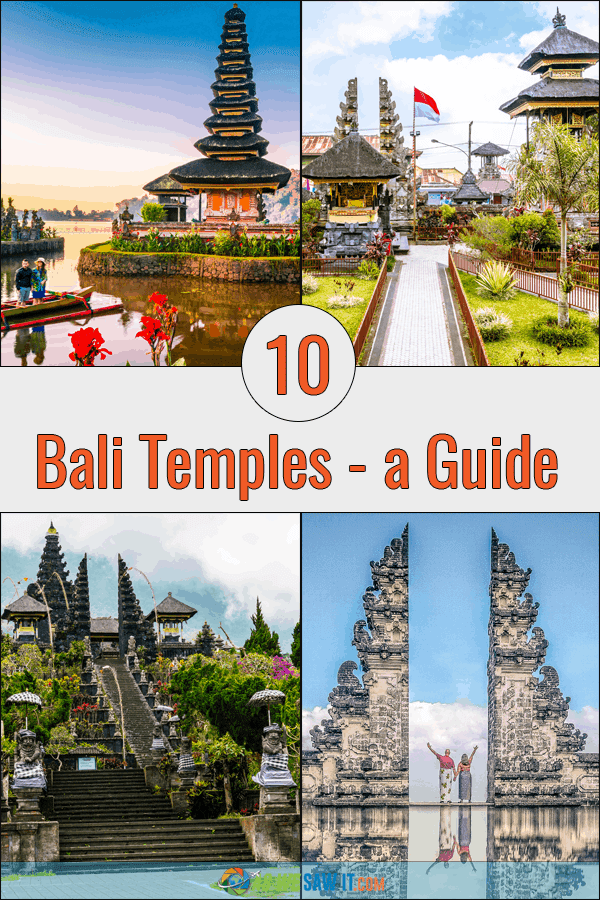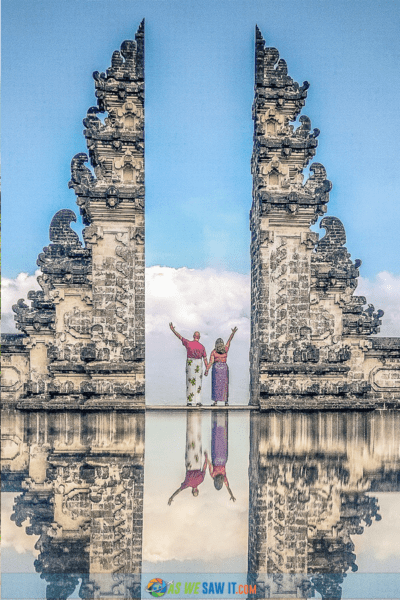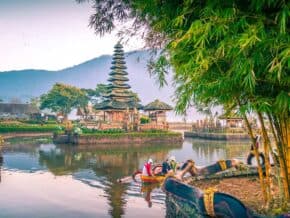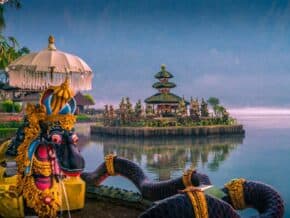From the moment you step onto the island, you’ll begin to sense why Bali is known as “the island of the gods.” Every bit of the island is steeped in spirituality, from the aroma of incense to canang sari (palm leaf offering trays) and statues of Hindu gods and temples at every turn.
Even if you come for surfing or diving, you’ll probably want to visit at least a few of the temples in Bali, too. After all, worship is an essential part of Balinese life and culture. Visiting a few of them is a great way to get an idea of how the people live and what they believe.
How many Hindu temples does Bali have?

Bali’ other nickname is “the island of a thousand temples,” and if anything, that’s an understatement. According to our guide, the island has 700+ Balinese communities. Every community has at least four temples. Three temples are dedicated to each of the three main Hindu gods, and every community also has one or more temples for everyday worship and protection. (The number depends on the population size.)
We daresay, most of the 2800+ temples in Bali are unremarkable. So, how do you know which Balinese temples are worth a visit?
Balinese Hindu temples 101
Before you travel, learning a little about pura (Balinese temple) symbolism and architecture will greatly improve your trip.
Balinese temples are complex. They could even be compared to living organisms in that the Balinese feed them with celebrations and offerings on auspicious days and at the full and new moons.
Balinese temple architecture
Each pura is surrounded by a high wall, which acts as the outer barrier of the temple. The wall not only provides privacy and protection from other people, it also wards off black magic and keeps evil spirits from entering the property.
Inside, you will find:
- candi bentar – split gate
- paduraksa or kori agung – roofed tower gate
- meru – thatched, multi-roofed towers that look like pagodas, always in odd numbers
- bale – pavilions used for chanting, offering, storing temple relics, etc.
- padmasana – a raised throne to one of the gods, and
- one or more shrines to various gods.
For more details about the various symbols that can be found around the temple, see Murni’s article about Balinese symbolism.

Temples are usually divided into three zones: outer, middle, and inner.
The outer zone (jaba pisan). There is only one entry, and it opens into the outer zone. This is a public area, connecting the everyday physical realm to the temple’s spiritual realm. They hold religious dance performances and festivals here.
The middle zone (jaba tengah). The entry to this zone is marked by a set of stairs, leading to one or more split gate (candi bentar). This is a zone halfway between the realm of people and the realm of the gods. This is where they store temple and festival equipment and prepare offerings.

The inner zone (jero) is the most sacred part of a pura. This is the realm of the gods and the focus of all ritual ceremonies. The only entry to this walled area is through a paduraksa roofed tower gate. This area is sometimes forbidden to all but priests.
The inner zone contains meru, bale, and a special raised throne known as a padmasana. The throne is for Acintya and sits on the back of a cosmic turtle that carries the universe on its back. It is usually positioned so the god’s back is facing Mount Agung.

Balinese gods
The Balinese recognize and worship a huge pantheon of gods, some Hindu, some traditional. As our guide explained, all of these gods are actually manifestations of a single, supreme, “all-in-one god”, Sang Hyang Widhi Wasa. Just as in the temple’s inner zone, if you notice empty chairs atop the shrines found outside houses and temples, it is reserved for him.
The top three manifestations of Sang Hyang Widhi are:
- Brahma – the Creator. Represented by the color red.
- Wisnu (Vishnu) – the Protector. Represented by the black color. He rides a garuda, which is half man, half bird; you’ll see that a lot in Bali.
- Siwa (Shiva) – the Destroyer. Responsible for death and re-birth, he has the color white.
You may notice banners, sashes, and more in these colors. Every color of the rainbow is symbolic and can represent multiple things, from gods to compass directions.

Basic temple rules and etiquette
Here are a few temple etiquette rules you will need to remember:
- Keep your knees and shoulders covered. Sarongs are usually available if you are not dressed appropriately.
- Keep the level of your head lower than that of the priest.
- Never walk in front of a praying Balinese.
- If someone is worshiping, use a zoom lens in order to take photographs from a respectful distance.
- Menstruating women may not enter a pura, as blood is considered unclean.
- Newborns may not enter either. The Balinese believe that babies are not fully developed until they are three months old (one year from conception).
While there is an island-wide council of Balinese elders, every temple in Bali is free to make its own rules. Some do not permit laypersons to enter the inner zone. Others require that shoes be removed, that sarongs be worn, or that hair must be tied back (I’m looking at you, Tirta Empul).
On the other hand, Pura Tanah Lot didn’t post any requirements at all. Most people are smart enough to remove their shoes before wading through the surf to the temple.
Bali has 9 directional temples.


Besides community temples, Bali also has a few central temples. Nine of them are set at auspicious locations around the island, such as the sides of tall mountains or overlooking the ocean.
The Balinese call these nine directional temples kayangan jagat, and they are meant to provide a barrier of protection against the evil spirits of the sea. Suffice to say that no matter where you are in Bali, you are probably near at least one of them.
Four of these are popular with tourists and often included in those “Best Temples in Bali” tour packages. They include:
- Pura Uluwatu – on top of a cliff,
- Pura Besakih – Sometimes called the Mother Temple, the Balinese consider It one of the island’s holiest temples.
- Pura Ulun Danu Beratan – a temple by the lake
- Pura Goa Lawah – a bat cave,
Rounding out the list of 9 directional temples are:
- Pura Batukaru – featuring a unique meru tower with seven distinct levels
- Pura Lempuyang – a 7-leveled temple that’s a challenge to climb
- Pura Masceti – on a sacred beach
- Pura Pasar Agung – on the slope of Gunung Agung, the highest mountain in Bali.
- Pura Ulun Danu Batur – the second-most important temple in Bali
1. Pura Uluwatu

Uluwatu Temple, also known as Pura Luhur Uluwatu, is well known for its beautiful location. It is perched on a cliff about 70 meters above sea level, overlooking the sea at Bali’s southernmost tip. This is a strategic location for warding off any evil spirits who want to invade from the sea.
Two lookout points offer particularly breathtaking views of the temple and the Indian Ocean, especially at sunset. One is north of Pura Luhur Uluwatu and the other to the south, in the stadium where Kecak Fire Dance takes place.
To get to the temple, you will need to walk through a forest that has several groups of monkeys. Balinese believe they protect the temple from bad influences. We say that’s ironic, considering how nasty these little creatures are. They will try to swipe anything they can, so hide your smartphones, take your sunglasses off, and zip your purse.
- Entrance fee: IDR 50.000
- Suggested tour: Bali Sunset: Uluwatu Temple, Kecak Dance and Jimbaran Bay
ⓘ Parents, watch your children! We visited with friends whose 2-year-old son disobeyed and ran ahead. A monkey suddenly appeared and grabbed one of his shoes. When it wouldn’t come off, rather than let go, the monkey dragged him down the road until we caught up and chased it off. The little guy wasn’t injured, but he was certainly shaken up. We’re telling you, Balinese monkeys are a hazard!
2. Pura Besakih

Pura Besakih, mother of all Hindu temples on Bali, stands majestically on the south-western slope of Mount Agung. This temple is considered the most important of all Balinese temples, and houses not less than 86 temples.
Pura Besakih features three temples dedicated to the Hindu trinity. The center temple is the largest and most impressive. Known as Pura Penatarana Agung, it has 22 temples on six rising terraces and is dedicated to Siwa.
The pura on the right side has red banners for Brahma, the creator; and the pura with black banners, on the left, represents the preserver, Wisnu.
As the mother temple and center of all religious ceremonies, Pura Besakih is the only temple open to every devotee from any caste groups. You can visit other temples in Pura Besakih, but many of their inner courtyards are reserved for pilgrims.
- Entrance fee: IDR 60.000
- Suggested tour: Mother Temple of Bali and Lempuyang’s Gates of Heaven Tour
ⓘ TIP: For the best cultural experience, try to visit during a celebration or ceremony. The temple holds more than 70 important ceremonies, and each shrine has its own anniversary celebration as well. Dates vary, based on the Balinese calendar.
3. Pura Ulun Danu Beratan

Located in the mountain town of Bedugul, Ulun Danu Beratan is arguably one of the island’s most picturesque temples. This Instagram favorite sits on Beratan Lake, where the calm and almost perfectly motionless water makes the temple look like it is floating.
The “floating” temple complex consists of four shrine groups, each dedicated to a different deity: Siwa, Wisnu, Brahma, and Dewi Danu.
The lakes in this area are the main source of the rivers that irrigate the highlands of the island. Many farms depend on these waters for their livelihood, so the Balinese often hold ceremonies here to ensure the water supply for the coming year.
The Bedugul mountain background and the fine mist rising from the lake practically guarantee stunning pictures, especially if you get up early.
- Entrance fee: IDR 75.000
- Suggested tour: Northern Charm: Lake Bratan, Handara Gate, Waterfall & Swing
4. Goa Lawah
Goa Lawah, which means bat cave in Indonesian, is not a place you should visit if you’re afraid of bats. This temple is home to thousands of them.
The temple was built in the eleventh century by Mpu Kuturan, one of the first priests who brought Hinduism to Bali. Even today, people still visit the temple to make offerings and pray.
The best time to visit is in the morning, when people from neighboring villages come to the temple for their daily prayers. It goes without saying that visitors should keep a respectful distance and follow Balinese temple etiquette.
- Entrance fee: IDR 35.000
- Suggested tour: Full-Day Bird Watching Experience with Goa Lawah Temple

5. Pura Batukaru
Batukaru Temple sits on the slopes of Mount Batukaru, Bali’s second-highest volcano. It protects Bali from from evil spirits approaching from the west. It is dedicated to the mountain’s guardian spirit. Mahadewa is also considered the god of the air, water, and plants.
Built in the eleventh century, Batukaru features a seven-roofed meru. Besides the main shrine to Mahadewa, you will also find sanctuaries for Beratan, Tamblingan and Buyan lakes. The temple was destroyed during the war in the 17th century and only rebuilt in 1959.
One of this temple’s most important events is the annual pilgrimage to the summit of Mount Batukaru. On this day, many Balinese Hindus gather and climb to the summit at the same time.The entire resort is surrounded by forests.
- Entrance fee: IDR 15.000
- Note: Toilet facilities are provided, but there are no food or drinks.
- Suggested tour: Jatiluwih Batukaru Mountain Nature’s Best Tour
ⓘ TIP: Dress for cool, damp weather because the climate is both cool and foggy.

6. Pura Lempuyang
Lampuyang Temple, also known as the “stairway to Heaven,” is actually a complex of seven temples. The temples lie along a trail that leads to the top of Mount Lempuyang, and the views along the trail are incredible.
Located in east Bali, Pura Luhur Lempuyang was off the tourist circuit for years. Then someone posted an Instagram from the candi bentar on the first level. BAM! It instantly became a must-see spot on Bali.
- Entrance fee: IDR 20.000
- Suggested tour: Full-Day Instagram Highlights Tour
Even if you’re not fond of posting selfies, you should visit if you enjoy a challenge. Plan to take about 4 hours to climb the steps to reach the top. To conquer the summit, begin your challenge early in the morning, the coolest and quietest part of the day.
The view is spectacular from the top in the morning before the clouds set in. On clear days you will see Mount Agung, the highest mountain in Bali, and Mount Rinjani, the highest mountain on the nearby island of Lombok.
Just don’t complain on the way up. Locals believe that anyone who complains will not make it to the top.

7. Pura Masceti
Another lesser-known temple that is rarely visited by tourists, Pura Masceti temple Is located on the sacred Masceti Beach, on the east coast of the island.
According to legend, the god Wisnu, and Laksmi, the goddess of wealth and prosperity, often had long discussions here while admiring the beautiful scenery. Thus, sunbathing, water sports and swimming in the sea are strictly prohibited on this beach.
The temple is dedicated to farmers and subak, the system that keeps the rice supplied with water (now a UNESCO intangible heritage).
- Entrance fee: free

8. Pura Pasar Agung
Pasar Agung Temple is located on the southern slope of Bali’s highest and most sacred mountain. According to Balinese legend, Mount Agung was created from a fragment of Mount Meru (the center of the cosmos), and is full of energy and power.
Considered as the market of the gods, Pasar Agung literally means Agung market. People often come here to make sacrifices and pray.
But we’ll be honest: It’s not worth visiting if you have bad knees. There are literally hundreds of steps to navigate, and it takes about 20 minutes to mount the staircase from the parking lot to the temple entrance.
- Entrance fee: free
- Suggested tour: Mount Agung Sunrise Trekking Experience
For the more adventurous among you, both Pura Besakih and Pura Pasar Agung are the starting points for hikes to the summit. Read more about climbing this 3,033-meter high volcano here.
ⓘ Interesting fact: Pasar Agung actually lies closer to Mount Agung’s summit than Pura Besakih does.

9. Pura Ulun Danu Batur (Kintamani)
The final of Bali’s 9 directional temples is Pura Ulun Danu Batur. This temple is located near the Mount Batur volcano in Kintamani and is considered to be the second most important temple in Bali. Dating from the 1600s, it is dedicated to the god Wisnu and the local goddess Dewi Danu, goddess of water, lakes and rivers.
“Ulun Danu” literally translates as “head of the lake.” Logically, it should be next to the lake, but it’s not. Not anymore, anyway. A volcanic eruption devastated a village a century ago, destroying everything in the temple except one 11-roofed meru. The survivors rebuilt the temple uphill, on the outer rim of Lake Batur’s caldera.
- Entrance fee: IDR 50.000
- Suggested tour: Ulun Danu Beratan Temple, Handara Gate & Sunset at Tanah Lot

When is the best time to visit Bali?
The best time to visit Bali is between April and October. You’ll have little rain, low humidity and lots of sunny days.
If you want to save money, the best months are May, June, and October. Surfing is possible all year, but the best surf months are from April to the beginning of October.
The best months for a Balinese honeymoon are June or September.
Planning resources
Here are some resources to help you plan your own trip.
- Tourism authority: Click here for the official Bali tourist website
- Bali’s airport is Ngurah Rai International. Code: DPS.
- Airport to hotel. Taxis are available. Another option is to book a private limousine service. They will greet you with a sign in the airport, help with your luggage, and escort you to your hotel.
- Visas. Project Visa target=”_blank” rel=”nofollow noopener” is an easy-to-use tool that will tell you if you are eligible for Visa on Arrival (VOA).
- Currency. We use xe.com to calculate currency exchange values.
- Travel insurance. You’d be surprised at how cheap it is and how much it covers. Trust us: When an airline misplaces your suitcase for a week, you’ll be glad you have it. Learn more here.
How to get around Bali
Sometimes it’s not practical to take a taxi or walk.
- Grab is the Southeast Asian version of Uber. Having had too many scammy experiences with taxi drivers, we now use Grab (and Uber) whenever we can. Install the app before you arrive.
- Private driver. Bali has hundreds of private drivers. For the best chance of getting someone with good English skills, we recommend that you book a driver through Get Your Guide.
- Rental car. Find and book a rental car here. Unfortunately, they don’t do motorbikes.
- Public transportation. This website will help you plan a route by plane, train, bus, ferry and car.
Where to stay
Book a guided tour
Sometimes it’s best to have someone show you around and manage all the arrangements.
Organized tours—
G Adventures offers insanely affordable small group tours on all 7 continents. 100% guaranteed departures, even if you’re the only traveler. Expect local accommodation, cuisine, and transport to connect you with the planet’s people, cultures, landscapes and wildlife. Click here to look at their itineraries.
Day trips and excursions
When we travel, we use Get Your Guide a lot. It’s our go-to for food tours, attractions and activities. Click here to see what’s available in Bali.
See more
Want to see more of this destination? For more sightseeing, check out our Bali photo gallery.
Read more
Online
We have a whole series of articles about Bali here on As We Saw It:
- 9 Directional Temples of Bali: 10 Day Itinerary
- Indonesian Food: Try These Beach Snacks
- It’s Not All Roses on Bali
- 7 Best Things to Do in Bedugul, Bali
- What’s It Like to Live in Bali?
- Bali’s Seafood Paradise: Dinner on Jimbaran Beach
- Watch the Batik Artists in Ubud, Bali
On Amazon
- Periplus Adventure Guide to Bali: The Ultimate Guide to the World’s Most Spectacular Tropical Island
- DK Eyewitness Travel Guide Bali and Lombok
- Lonely Planet Pocket Bali Travel Guide







Beautiful guide on temples of Bali! To be honest, I’m not a temple hopper. I do take note of temples that are really old and fascinating, though. Bali seems to be a colorful and lively place. I guess perfect for a solo traveler like me, isn’t it?
Bali is a dream for solo travelers, Renuka! It’s cheap and you’ll be among many other singles. To be honest, there are so many things to do in Bali that you wouldn’t have time for much temple hopping. Anyway, thanks for the compliment; we worked hard on this guide.